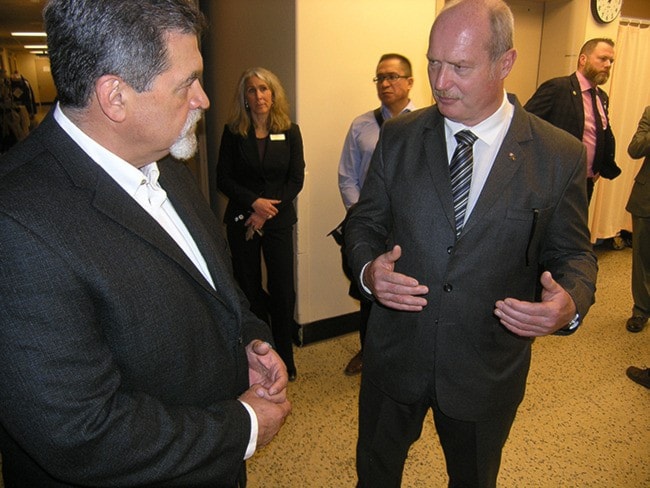PROVINCIAL finance minister Mike de Jong saw first hand last week the kinds of conditions at Mills Memorial Hospital which have lead to repeated calls for a replacement to be built.
Accompanied by a small party of health care administrators and local elected officials, de Jong spoke with doctors and nurses and briefly popped into one of the crowded four-bed rooms to spend a few minutes with patients during a tour of the aging building Oct. 4.
In a small hallway behind the second floor nursing station, Mills Memorial head nurse Jacqueline Wilkinson showed de Jong a small bathing room used by patients.
“We have three of these and three shared showers,” she said of patient amenities noting that in the maternity section, 320 and 350 deliveries a year take place.
Wilkinson also told de Jong the main nursing floor has 25 beds and routinely holds between 28 and 32 patients. “Sometimes it’s a stretch to make it work … all that juggling,” she said.
Inadequate space makes sanitary conditions difficult to maintain, she added, telling de Jong that both clean and dirty items are stored in one small utility room.
Wilkinson also told de Jong that Mills is simply too small and too inadequate to efficiently put in place and use the more modern equipment that is part of today’s health care.
“The patients we have today are far more complicated and complex,” she said, referencing the growing use of Mills as a regional hospital in a city where the number of specialists now outnumbers the number of general practitioners working here.
De Jong also spoke with Dr. Jaco Fourie, the Northern Health Authority’s medical director for the region.
Referring to the stance of the province that it won’t yet commit to a new hospital, Fourie told de Jong that “when it became apparent we weren’t to get a new facility, you could just feel the gloom.”
Speaking afterward, de Jong conceded that the conditions at Mills were inadequate and the facility is past its prime.
“To be candid, I’d say it needs to be replaced,” said de Jong of the building, dismissing the prospect of an extensive renovation being considered.
But he repeated the provincial government’s position that it won’t say ‘yes’ to a new Mills Memorial Hospital until it’s ready to commit itself financially to the project.
And that even extends to having someone else pay for a business case study that would define the project’s scope and costs.
That’s been the standing offer of the North West Regional Hospital District which has been rejected by the province for the past two years.
The hospital district is made up of portions of three northwestern regional hospital districts and through its taxing authority, finances 40 per cent of major hospital construction projects and equipment purchases.
“As you know those kinds of studies can become out of date rather quickly,” said de Jong of the offer made by the hospital district.
He said the province does not want to have a dollar figure attached to a Mills replacement until it is ready to proceed with the steps leading to construction.
The Northern Health Authority had already commissioned a concept study two years ago for a new Mills, considered one of the preliminary steps leading to eventual construction.
That included extensive discussions with local nurses, physicians and health care professionals as to what kind of facility is needed and what kind of services it should provide.
Construction estimates have since then risen to the $450 million range.
De Jong wouldn’t say exactly where a new Mills sits on the province’s list of capital projects or when it might take the next steps.
“We have just recently been able to pay down the [provincial] debt by $1 billion so that should give us a bit of room,” he said.
But de Jong noted that “there is an infinite demand for a finite number of dollars.”
Aside from the construction cost, is the need to pay for the kinds of services a new Mills would provide, the minister stated.
The Northern Health Authority wants a new Mills to be classified as a Level III trauma centre, meaning that it will be able to handle the kinds of extremely serious patient cases which now require transfers to the Lower Mainland.
That would mean recruiting more physician and nursing specialists as well as beefing up the hospital’s current lab and other services.
De Jong said he was impressed with what Mills is able to now provide to its patients given its current limitations.
“It’s actually quite a story and I don’t think it was fully appreciated,” he said.
De Jong was in the area last week on a mixture of government and B.C. Liberal business.
He said he wanted to tour Mills after city council raised the issue while the mayor and councillors were at the recent Union of B.C. Municipalities convention in Victoria.
The council’s lobbying efforts for a new Mills continued in Terrace at a private session with de Jong prior to the hospital tour.
Also on the Mills tour with de Jong were mayor Carol Leclerc, city councillor Sean Bujtas, Kitselas First Nation chief councillor Joe Bevan and Skeena riding BC Liberal candidate Ellis Ross.
The finance minister also attended an event the same day as part of the tour to raise money for Ross in his campaign for next year’s provincial election.
